Ageing and the border between health and disease, 2014
- Ageing is characterised by a progressive degeneration of the tissues that has a negative impact on the structure and function of vital organs. Loss of physiological integrity, resulting in a progressive decline of homeostasis and reduced capacity to respond to environmental stimuli with age, contributes to an incremental risk of disease and death.

The poly-omics of ageing through individual-based metabolic modelling, 2018
Abstract
Background
Ageing can be classified in two different ways, chronological ageing and biological ageing. While chronological age is a measure of the time that has passed since birth, biological (also known as transcriptomic) ageing is defined by how time and the environment affect an individual in comparison to other individuals of the same chronological age. Recent research studies have shown that transcriptomic age is associated with certain genes, and that each of those genes has an effect size. Using these effect sizes we can calculate the transcriptomic age of an individual from their age-associated gene expression levels. The limitation of this approach is that it does not consider how these changes in gene expression affect the metabolism of individuals and hence their observable cellular phenotype.
una causa molti sintomi
prendiamo come causa di malattia l’invecchiamento, che si accompagna ad un aumento di frequenza di moltissimi sintomi e porta infine alla morte.
Mechanisms of aging
In adults, hypothyroidism is associated with the following:
• Slowed speech and a hoarse, breaking voice. Deepening of the voice can also be noticed.
• Impaired memory
• Impaired cognitive function (brain fog)
• Urticaria (hives)
• Migraine headache
• Increased sensitivity to heat and cold
• A slow heart rate with ECG changes including low voltage signals. Diminished cardiac output and decreased contractility.
• Pericardial effusions may occur.
• Sluggish reflexes
• Dry puffy skin, especially on the face, and hair loss, especially thinning of the outer third of the eyebrows
• Depression (especially in the elderly)
• Mild weight gain
• Anemia caused by impaired hemoglobin synthesis (decreased EPO levels), impaired intestinal iron and folate absorption or B12 deficiency from pernicious anemia
• Slowed metabolism
• Constipation
• Fatigue (physical)
• anxiety/panic attacks
• Choking sensation or difficulty swallowing
• Shortness of breath with a shallow and slow respiratory pattern.
• Impaired ventilatory responses to hypercapnia and hypoxia.
• Increased need for sleep

• Muscle cramps and joint pain
• Brittle fingernails
• Osteopenia or Osteoporosis
• Paleness
• Irritability
• Yellowing of the skin due to impaired conversion of beta-carotene to vitamin A
• Abnormal menstrual cycles (Specifically Menorrhagia)
• Impaired renal function with decreased GFR.
• Thin, fragile or absent cuticles
• Infertility or difficulty becoming pregnant
• Elevated serum cholesterol
• Mood instability
• Acute psychosis (myxedema madness) is a rare presentation of hypothyroidism
• Poor muscle tone (muscle hypotonia)
• Decreased libido
SINTOMI
Ipotiroidismo
Neuropatie
Attacchi simil-epilettici
Dolori articolari
Vasculiti
Infarto
Ictus
Osteoporosi
Psoriasi, tumori pelle
Carcinoma Mammella prostata
Primary events
Aging
IPOTESI DI LAVORO
La causa prima dell’invecchiamento è la diminuita sintesi di ormoni steroidei (DHEA solfato) da parte del surrene
Cause di tale fenomeno:
• fattori genetici
• fattori prenatali
• stile di vita
• dieta
Conseguenze:
• calo estrogeni
• calo sintesi dell’eme
• riduzione di tutte le proteine con eme
• emoglobina
• NO-sintetasi (NOS)
• COX-1 e-2
• Idrossilasi di ormoni vari
• Idrossilasi di Vit D3
• Aromatasi
• NADPH ossidasi (macrofagi)
Serum DHEAS and aging

DHEAS metabolism

Therapy
Ageing and metabolism: drug discovery opportunities 2005

Schematic view of iron transport regulation. Two transporters (DMT1 and ferroportin 1) are essential in duodenal enterocytes for the iron uptake from foods. Ferroportin 1 is also a receptor for hepcidin, a peptide hormone secreted by hepatocytes. The interaction blocks the function of ferroportin 1 as iron transporter. Catechol-Fe(III) complex was recently proposed as non-transferrin-bound iron in the serum, which is recovered by lipocalin 2 [45]. Catechol may come from plants as foods. This ternary complex is redox-inactive and taken up by lipocalin 2 receptor (megalin) of the renal proximal tubules to give back to the serum transferrin system. Ferroportin 1 is the iron exporter from most of the cells, but there is no route of iron disposal to outside of the body. TF, transferrin; TFR1, transferrin receptor 1.
S. Pombe for ever young
Tolić-Nørrelykke
Fission Yeast Does Not Age under Favorable Conditions, but Does So after Stress. 2013
BACKGROUND:
Many unicellular organisms age: as time passes, they divide more slowly and ultimately die. In budding yeast, asymmetric segregation of cellular damage results in aging mother cells and rejuvenated daughters. We hypothesize that the organisms in which this asymmetry is lacking, or can be modulated, may not undergo aging.
RESULTS:
We performed a complete pedigree analysis of microcolonies of the fission yeast Schizosaccharomyces pombe growing from a single cell. When cells were grown under favorable conditions, none of the lineages exhibited aging, which is defined as a consecutive increase in division time and increased death probability. Under favorable conditions, few cells died, and their death was random and sudden rather than following a gradual increase in division time. Cell death correlated with the inheritance of Hsp104-associated protein aggregates. After stress, the cells that inherited large aggregates aged, showing a consecutive increase in division time and an increased death probability. Their sisters, who inherited little or no aggregates, did not age.
CONCLUSIONS:
We conclude that S. pombe does not age under favorable growth conditions, but does so under stress. This transition appears to be passive rather than active and results from the formation of a single large aggregate, which segregates asymmetrically at the subsequent cell division. We argue that this damage-induced asymmetric segregation has evolved to sacrifice some cells so that others may survive unscathed after severe environmental stresses.